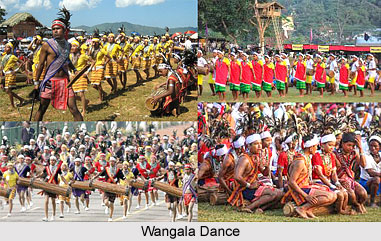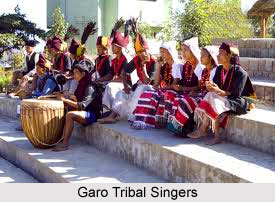Festivals of South Garo Hills District portray the enthusiasm and zeal of the people of South Garo Hills and they include the Wangala dance and etc. There are no organized games as such among the Garos, though this does not imply that they have nothing to amuse themselves with. Games are generally played occasionally.
 Jumping contests and other competitions are indulged in more as tests of strength. The young males, members of the Nokpantes or Bachelors` Dormitories, may organize themselves into groups and engage in such contests as the wa`pong sika, the Garo version of the tug-of-war, in which a stout bamboo pole replaces the rope and the contesting teams try push each other beyond a marked line instead of pulling. Again, the villages may turnout in strength to take part in communal fishing.
Jumping contests and other competitions are indulged in more as tests of strength. The young males, members of the Nokpantes or Bachelors` Dormitories, may organize themselves into groups and engage in such contests as the wa`pong sika, the Garo version of the tug-of-war, in which a stout bamboo pole replaces the rope and the contesting teams try push each other beyond a marked line instead of pulling. Again, the villages may turnout in strength to take part in communal fishing.
The common and regular festivities are, of course, those connected with agricultural operations. Greatest among Garo festivals is the Wangala which is more a celebration of thanksgiving after harvest in which "Saljong", the god who provides mankind with Nature`s bounties and ensures their prosperity, is honoured. There is no fixed date for the celebration; this varying from village to village, but usually, the Wangala is celebrated in October. Preparations take place well before the date; items of food are among the first to be collected. The Nokma of the village takes the responsibility to see that all arrangements are in order. Rituals in his house and in the individual fields precede the feasting at which guests are literally force-fed by the hosts. A large quantity of food and rice-beer must be prepared well ahead. The climax of the celebrations is the colourful Wangala dance in which men and women take part in their best clothes. Lines are formed by males and females separately and to the rhythmic beat of drums and gongs and blowing of horns by the males, both groups shuffle forward in parallel lines. Variety is added by the performance of a skilled dancer who ties a large fruit to the end of a string about half a meter in length and by a skilful manipulation of his body sets it swinging round and round behind him. This part of the dance usually wins enthusiastic applause.
Christian work inside Garo Hills having started about 1878 with the American Baptists who had, however, started their work among Garos in Goalpara since 1867. The Roman Catholics began their work in the plains areas first around 1931 -32, following it up with the establishment of a base at Tura (1933); since then it has extended to other parts of the Garo Hills. Between 1961 and 1971 the number of people returned as "Songsarek" underwent a decline and it would appear that their decrease has largely been due to the advance of Christianity. It can indeed be stated that the vast majority of Garos profess only these two beliefs that is, they are either Songsarek or Christian.
 In earlier works on the Garos, as indeed on all the tribes of the North-East, the tenn Animism, was applied to the tribal faiths. This was perhaps oversimplification of a complex subject. It is true that much of Garo religious practices relate to Nature. They attribute the creation of the world to the Godhead, Tatara-Rabuga. Next in rank but more intimately concerned with human affairs is Saljong, who is the source of all gifts to mankind. He is honoured with the Wangala celebrations. Another benign deity is Chorabudi, the protector of crops. The first fruits of the fields are offered to him. He is also honoured with a pig sacrifice whenever sacrifices are offered to Tatara-Rabuga.
In earlier works on the Garos, as indeed on all the tribes of the North-East, the tenn Animism, was applied to the tribal faiths. This was perhaps oversimplification of a complex subject. It is true that much of Garo religious practices relate to Nature. They attribute the creation of the world to the Godhead, Tatara-Rabuga. Next in rank but more intimately concerned with human affairs is Saljong, who is the source of all gifts to mankind. He is honoured with the Wangala celebrations. Another benign deity is Chorabudi, the protector of crops. The first fruits of the fields are offered to him. He is also honoured with a pig sacrifice whenever sacrifices are offered to Tatara-Rabuga.
Living so close to Nature, the early Garo people the world around them with a multitude of spirits called mite, some of them good and some of them capable of harming human beings for any lapses they might commit. Appropriate sacrifices are offered to them as occasions demand. In all religious ceremonies, sacrifices were essential for the propitiation of the spirits. They had to be invoked for births, marriages, deaths, illness, besides for the good crops and welfare of the community and for protection from destructions and dangers.
Like the Hindus, the Garos used to show reverence to the ancestors by offering food to the departed souls and by erection of memorial stones. Like other religions, the Songsarek religion ascribes to every human being the possession of a spirit that remains with him throughout his lifetime and leaves the body at death. There appears to be a belief in reincarnation, people being reborn into a lower or higher form of life according to their conduct in their lifetime. The greatest blessing a Garo looks forward to is to be reborn as a human being in his or her original Ma`chong or family unit. Garo society is entirely casteless.






